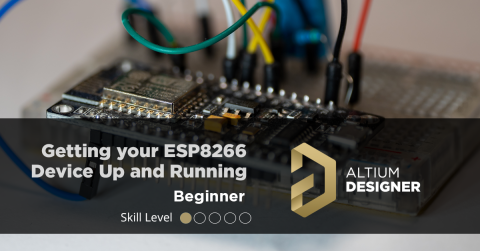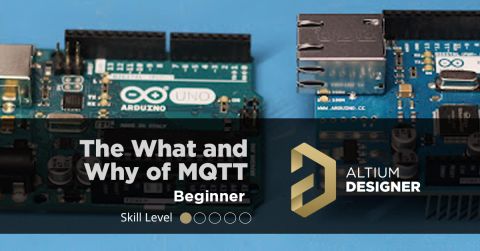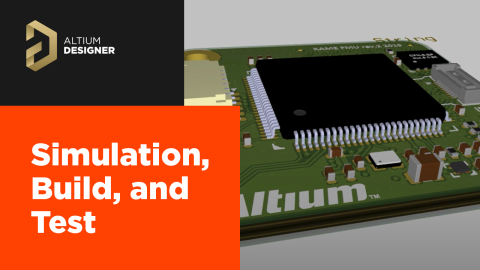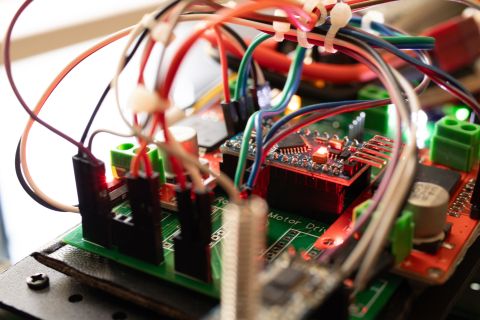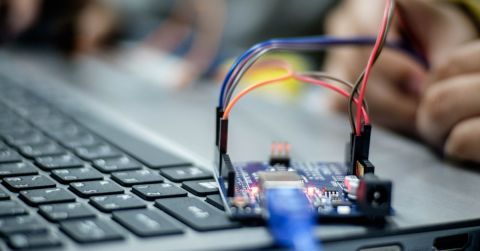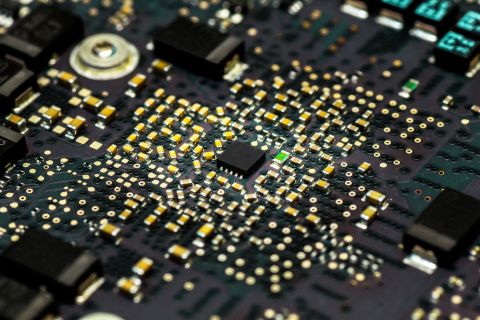Altium Syncs Your Design and PCB Programming Software

Embedded development and design can’t be considered separate from the firmware portion of a project. Embedded systems need some level of firmware development or a fully embedded OS to run an application, and the firmware development needs to happen alongside the hardware development portion of a project. Syncing everything takes a comprehensive set of design and management tools, as you’ll find in Altium Designer and Altium 365. You can keep track of everything you need in PCB design, PCB programming language, component sourcing, and much more as you develop your embedded application.
PCB design software for embedded systems design and development. Access the complete set of embedded systems project management features and learn how to program a PCB board in Altium 365.
Embedded systems design is unique in that it brings together firmware or software development and electronic hardware design. Multiple aspects of electronics engineering, software engineering, PCB programming language, and mechanical design converge on each other in these projects, and teams need a suite of product development tools to bring new embedded systems to production and ultimately to market. Most importantly, each member of a design team needs visibility into all other aspects of a design through simplified access to MCAD models, firmware code, and PCB manufacturing files and documentation.
Altium Designer and Altium 365 bring a complete set of design tools together with project management features into a single program. Anytime a design is created in Altium Designer, the embedded team can attach firmware to the project and manage everything through the version control system in Altium 365. During the project, an embedded team needs a set of development tools to work with their chipset and write production-grade code for their application. Keep reading to see the workflow you can create with Altium Designer and your PCB programming tools via the Altium 365 platform.
Create a Design Workflow With PCB Programming Software
So, how to program a PCB board? To start developing your application for your embedded system, you need to access the IDE and SDK from your component manufacturer and download them onto your local computer. Generally, any IDE can be used to develop code for your embedded application, although your chipset manufacturer may have released a proprietary IDE for your components so that you can develop your application. However, once you finish your code and have tested all logic cases, you’ll need to use your manufacturer’s developer tools to compile your code to a binary so that it can be flashed to the component on the PCB.
Using your component manufacturer’s IDE as your PCB programming software is the preferred route for developing your embedded application, as they can easily integrate their SDK and any required libraries into their IDE. Instead of developing all libraries from scratch, using manufacturer-supplied libraries and open-source libraries helps you cut down development time while using proven code to develop your embedded application.
Altium 365 Links Your Embedded Code and Hardware Design
To keep track of your code for your embedded application, Altium 365 gives you the tools you need to store, track, and access all embedded code for your project. A design team can add embedded code to an Altium Designer project and store this data in Altium 365. Everything is entered into the integrated Git-based version control system, where revisions to code are tracked and hardware revisions can be packaged with all embedded code and manufacturing data. No other platform provides this type of integration with your PCB programming language and design software.
- Altium 365 allows you to share individual files through managed folders or entire projects with collaborators. You can also enter high-volume production by sharing manufacturing data through Altium 365.
Learn more about sharing design data through Altium 365. - Your Altium 365 Workspace allows you to share with internal team members and external stakeholders.
Learn more about your Altium 365 Workspace and sharing workflows. - An important part of product development is mechanical design. ECAD and embedded development teams also need to interface with MCAD tools as part of project management and product development.
Learn more about ECAD/MCAD collaboration in Altium Designer.

Share, access, and download your embedded firmware code directly from your Altium Designer project files in Altium 365.
Develop Your PCB Layout and Code in Parallel
Embedded systems have to live on a circuit board, and the board design will ultimately inform how the product or application is developed. While the embedded team builds code for your product, you can work on building the schematics and PCB layout inside Altium Designer while keeping track of all project data in a single platform. Altium Designer includes a comprehensive set of PCB design and layout tools to help you design powerful hardware platforms and prepare designs for manufacturing.
Some of the major features you’ll find in Altium Designer include:
- A hierarchical, multichannel schematic editor with built-in library access features and a SPICE simulator with an intuitive interface
- CAD tools for PCB layout and routing that accurately place components, traces, copper pour, vias, pads, and any other feature you’ll find in a PCBA
- Post-layout simulation tools to examine crosstalk, reflection waveforms, length/delay tuning, and impedance matching
- Integration with enterprise-level MCAD design applications and field solver applications
- A complete set of manufacturing file generation features to instantly generate fabrication and assembly data in standard formats
- Native 3D design tools to help you check interferences and visualize the mechanical behavior of your system
Altium Designer’s PCB Editor includes everything needed to design high-quality electronics without requiring external programs for simple design tasks. Design teams can take a methodical approach to PCB design and embedded systems development.
The Most Powerful PCB Programming and Design Features in a Single Program
The power of Altium Designer comes from the integrated design rules engine, which ensures your PCB layout complies with basic electrical rules and DFM rules. You can use Altium Designer’s PCB Editor to establish requirements for your design by setting the standard and custom design rules for every aspect of your PCB layout. With this approach, you can write an instruction set that governs routing widths, plane connection styles, routing styles, and clearances applied to individual net classes, layers, objects, and much more. You can take full control over your design tools and your PCB layout for embedded systems with Altium Designer.
- Altium 365 can function as your centralized data management platform in the cloud. You can store, access, and manage all of your hardware data and embedded code in Altium 365.
Learn more about PCB data management in Altium 365. - Altium Designer and Altium 365 work together to help teams move through PCB design reviews by facilitating data sharing in a unified platform.
Learn more about getting through PCB design reviews. - Altium Designer streamlines the entire process for designing PCBs, starting with schematic editor tools and component management, and ultimately generating PCB manufacturing files in standard formats.
Learn more about designing a PCB in Altium Designer.

Create your entire circuit board layout, PCB fabrication notes, and manufacturing data in Altium Designer.
Store All Your Embedded Systems Project Data in Altium 365
The power of Altium 365 is its file-sharing and storage capabilities, as well as an integrated version control system for hardware development. All aspects of a project can be stored, and revisions can be tracked with Altium Designer, which can be used as a portal into the managed cloud platform in Altium 365. Hardware and embedded designers can access each other’s data by simply opening a project in Altium Designer.
Altium Designer is the industry standard for PCB programming language and design in all other areas of electronics development. From high-speed embedded computers to high-frequency RF products for any industry and market segment, Altium Designer’s integrated set of PCB design tools helps you build advanced electronics and prepare them for full-scale manufacturing. Whether you’re ready to deploy a prototype or you need to prepare to scale to high volume, Altium 365 will function as the link between your PCB design team, embedded developers, and your manufacturer.
Scale Up Production of Embedded Systems with Altium 365
Once you’re ready to prepare your design for PCB fabrication and assembly, each file needed by your manufacturer can be quickly generated inside Altium Designer in standard formats. The OutJob file feature in Altium Designer instantly takes your PCB layout data and your BOM, and it generates standard deliverables needed by fabricators and assemblers. The deliverables you create in Altium Designer automatically incorporate sourcing information for your components, helping ensure accurate assembly, testing, and flashing of your embedded firmware on the production line.
- Altium Designer gives all users everything they need to create advanced electronics and prepare circuit board layout documentation. Altium gives you the best printed circuit board programming and design tools to help you stay at the cutting edge of new technology.
Learn more about Altium Designer’s complete toolset for printed circuit board design. - Altium Designer users can easily push their design, fabrication, and assembly data to manufacturing partners via the Altium 365 platform, the industry’s only managed cloud platform for design collaboration.
Learn more about sharing your PCB project data with Altium 365. - The simplified interface in Altium 365 is ideal for storing and sharing all your project data, including code for your embedded firmware.
Learn more about using Altium 365 to host and share your firmware code.

Altium 365 enables a comprehensive view of your PCB projects and manufacturing data in a single platform.
Altium Designer and Altium 365 come together to help you manage all aspects of your project, including your printed circuit board programming software libraries, binaries, and project files. Let Altium 365 be your go-to project management and data management solution. You’ll have access to the industry’s best sharing and collaboration tools for PCB designers and embedded systems designers.
Altium Designer combined with Altium 365 delivers an unprecedented amount of integration to the electronics industry, allowing designers to work from home and reach unprecedented levels of efficiency.
We have only scratched the surface of what is possible to do with Altium Designer on Altium 365. Ready to experience a truly unified electronics design environment? Start your free trial of Altium Designer and discover how extensions and the Altium 365 application suite can help you work smarter, not harder.



